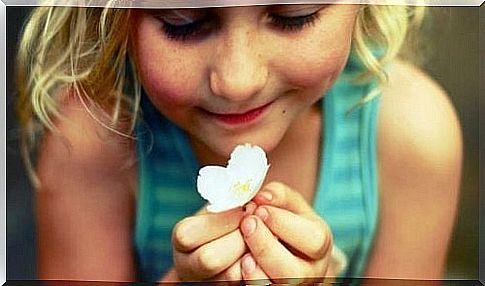Children Need Emotional Expression

Adults often comfort children who are upset with expressions such as: “don’t cry,” “big kids are strong,” or “you must be brave.” It seems to work with certain children, at least for a while. However, it can lead to children learning to keep their feelings to themselves. This has implications for the psychological and social development of children, as they need emotional expression.
Ignoring or denying children’s feelings is dangerous. That’s why it’s a good idea not to do this if you want them to be in good emotional health. It can also affect their relationships with other people.
Just because they are small doesn’t mean their thoughts and emotions aren’t important. The opposite is even true.
The truth is that their world is just as important as ours, as are their feelings and ideas. Our job is to support them as best we can as they get to know themselves.
Let’s take a closer look at the wonderful task of teaching children emotional expression and understanding their feelings.
The Danger of Suppressing Children’s Emotional Expression
Anger, sadness or irritation are natural reactions of children to different situations. They may not understand what is happening or because they didn’t get what they wanted. Maybe it’s just a tantrum. Whatever the reason, these emotions carry a message that says more than just “ I’m upset. Our job is to understand that message.
The first thing we need to do is interpret the child’s tears or anger and find out what’s going on. If we instead reject the emotions and pay no attention to them, we contribute to the negative emotions. We also reject their identity. We demand behavior that is convenient for us but based on fear and emotional rejection.

If we suppress children’s emotions, they will not learn to manage their emotions as adults. This applies to themselves as well as to relationships with others, and will negatively affect their well-being. It also limits the development of their emotional intelligence. As psychologist Daniel Goleman says, self-knowledge and knowledge of one’s own feelings is the pillar of emotional health. It is the basis of personal growth.
Children’s emotional expression
We have little experience teaching children to express themselves and their emotions. This is especially true when we talk about negative emotions such as anger, irritation or sadness. We even think that children who express these emotions are rude, poorly trained or aggressive.
If we don’t teach them to connect with their emotional selves, they will never learn to understand themselves. As a result, they never learn to manage their feelings.
If we want to raise emotionally intelligent and healthy children, we must teach them emotional self-expression. If we don’t do this, they will become more and more upset, until they start expressing themselves in a different way. They become prisoners of their emotions.
Expressing irritation or sadness offers relief and healing. It also helps us move forward and understand ourselves. That’s why it’s so important. If you teach children good emotional expression from a young age, they become emotionally healthy adults. Investing in an emotional education for the little ones is an investment in the future of adults. We must not forget this.
How can we teach children to express their emotions?
There are many ways for children to express how they feel and channel their negative energy. This ranges from tears to the process of learning to identify their emotions step by step.
The important thing is to be aware that this is a necessary process for them. Never respond with anger, criticism or threats. We must never lose control. We have to support them during those moments, because they can’t solve their own problems yet. This is especially true in the early years of life. Children need a quiet environment, without people feeding their anger.
Our attitude with children must arise from a place of love, listening and empathy. In this way, we can teach them to find out what causes their emotions and how to express them. This process will also help them with the ability to manage their emotions.

Something to avoid is trying to reason with a child who is angry or caught off guard. We can imagine them expressing how they feel, but it often pays off to wait a few minutes for them to calm down.
That’s the best time for a good conversation. We can encourage them to express what they feel. It is also important that we teach them to understand that they behave appropriately when expressing themselves. It is important that they do not hurt or hurt anyone.
The traffic light technology
A popular technique for teaching children emotional expression is the traffic light technique. The aim is to teach children to associate their emotions and behavior with the colors of a traffic light. To do this, we draw a traffic light and explain the following:
- Red light: We associate this color with stopping. So if you feel angry or nervous, or want to yell or fight, remember that the light turns red and you have to stop. It’s like being the driver of a car and having to stop at a traffic light. The message is that you stop, calm down, and think .
- Yellow light: This color means that you need to stop and think about what the problem is, and what you are feeling. At a yellow light, the drivers stop, look around, and look for solutions to continue. In this case, the message is that you think about solutions and consequences.
- Green light: This color means you can continue. Choose the best solution and make it happen. The message now is that you go ahead and choose the best solution.
Another technique that often works with upset children is asking if they can draw their anger. Then talk to them about anything they need. Then they can tear the drawing to pieces. This is a symbolic way to release their anger after they deliver their message.
They can also count to ten, spend some time alone, or take deep breaths. Later, you reflect together on why they felt this way. Talk about how to channel their feelings and solve their problems. That last part will encourage their awareness and emotional expression.

As we can see , children can express negative emotions. However, they often do not know how to do this. Our job is to help them express themselves with a positive emotional education, based on understanding and love.








